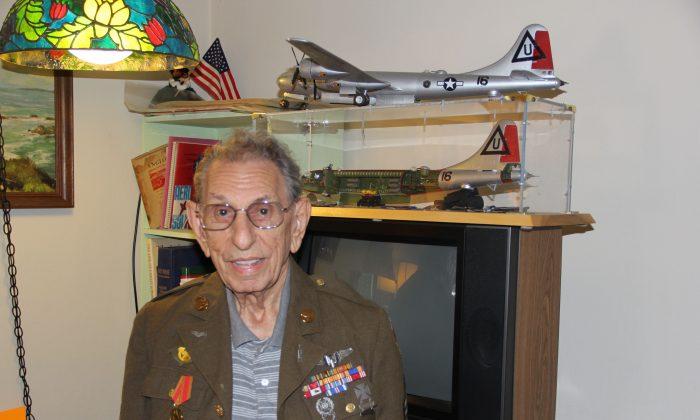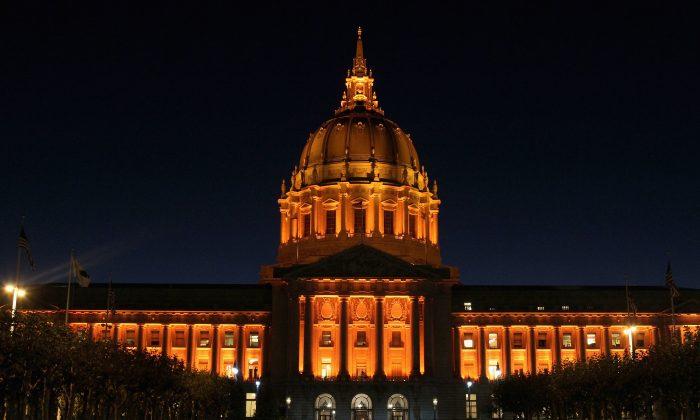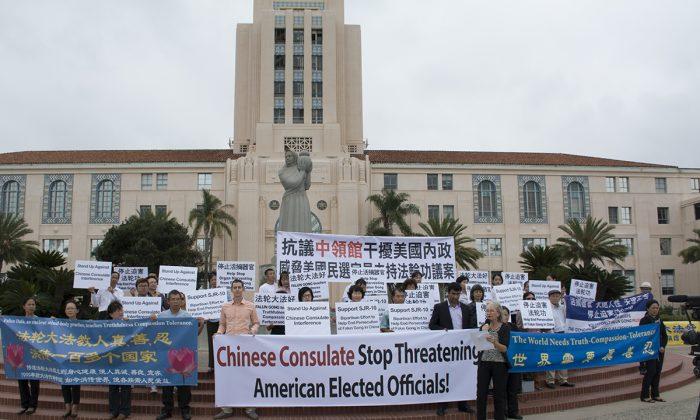Seventy-one years ago on Aug. 15, Japanese Emperor Hirohito spoke for the first time on national radio, announcing to his subjects that Japan would surrender to the Allied forces. The United States immediately accepted and the entire nation breathed a sigh of relief.
Just like that, World War II was over—our boys were coming home.
Decorated veteran George Allen was one of those soldiers eager to return to his family. Now 90 years old, he vividly recalls the harrowing time he spent serving his country over 71 years ago.
“I’m a dummy. I left high school and enlisted when I was 17. I wanted to be an air jockey—to fly airplanes. I thought it was going to be great,” said Allen.
He ended up as a tail gunner on a B-29 bomber—a long-range heavy bomber capable of flying higher and farther than other airplanes used in the war.


His first eight missions were “over the hump”—meaning the Himalayas—in order supply China with food, oil, and ammunition to help them fend off the Japanese, who had invaded Manchuria. “We flew eight missions over and were successful each time,” Allen said.
Afterward he was stationed at Tinian, a part of the newly captured Mariana Islands. Possession of these islands gave the United States a base for their new long-range B-29 bombers, enabling them to now be flown directly over Japan.
They started bombing Japan from 30,000 feet in the air, a distance that felt fairly safe to the crew. What they didn’t realize was that when bombs were dropped from that height, they often missed their targets, something U.S. General Curtis LeMay brought to their attention when he took over the missions.
“He told us, ‘You dummies, you’re missing the target by 5 miles. We’re going to stop dropping from 30,000 and go down to 5,000.’ An officer stood up and asked him, ‘Won’t that increase our chances of being shot down?’ And the General says, ‘Yes, your losses will probably double,’” Allen recalled.
“There were 1,000 of us on that hillside listening and we just let out a collective groan. ‘Double!?’
“But he explained that by doing it this way, we‘d accomplish what we were there for, to bomb the Japanese. He told us, ’It’s no good dropping bombs if you’re not hitting your targets, you’re losing people anyway and it’s foolish to give up your life and get nothing.'”
Flying from that lower elevation definitely increased the gun fire directed at Allen’s crew. They were shot down twice. He vividly recalls bailing from the window of the B-29, flames roaring from the wings toward the fuel tank.
As he plummeted from the sky toward the ocean below, he thought, “My God, you’re 19 years old, not going to live to 21, you'll never be a man. It’s over.”
It wasn’t, though. He landed in the water where he found himself all alone. The crew was scattered over such a wide distance that they couldn’t see each other. He had been floating for an hour, terrified of sharks, or that the Japanese were going to find him, when he suddenly saw the periscope of a submarine. Allen thought for sure it was the Japanese.
“When it (the periscope) stopped, my stomach dropped. I thought, ‘Well, this is it.’”
Because of a horrific story he'd heard about a friend and fellow soldier who was captured by the Japanese, Allen kept a .45 revolver strapped to his waist on every mission he flew.
“If I had to jump and hit land, I planned to use it on myself rather than let them get me. It may sound cowardly, but the stories I‘d heard were too horrible.” However, he’d landed in the water. His .45 was useless.
To his relief, the periscope disappeared, but then it returned 45 minutes later. “I thought, ‘They went to get some good stuff for me, no doubt.’”
When the submarine rose, to his overwhelming joy he saw that it was American. “They rescued me and told me I got to be a sailor for a week. Well, I didn’t mind. The food was better than we had in the Air Force!”
Allen was also part of the March 9, 1945, firebombing mission of Tokyo. Over the course of 48 hours, 2,000 tons of incendiary bombs were dropped from 334 B-29 bombers. Almost 16 square miles in and around the Japanese capital were incinerated.
Allen recalled the scene: “Take off was every sixty seconds. We flew wing tip to wing tip, planes two hundred feet above and below you. Because it was night you could hardly see, so this formation gave us the best chance of not running into each other.
“We went over at 400 feet, and, what a ride! ... The turbulence from the fires almost turned us upside down—we turned up 90 degrees—can you imagine? Our wingtip was pointing to the ground! It was terrible.”
Terrifying missions like this continued for Allen and the others who served alongside him until that magical day in August when the Japanese surrendered. What a moment—to realize that there were more chapters to be written in his life story. He'd get to go home, attend college, marry, raise a family—experience all of the milestones that the millions of soldiers around the world who paid the ultimate sacrifice for their countries wouldn’t.

One would think that reminiscing over his years in combat would darken Allen’s view of the war. However, with a mischievous gleam in his still bright eyes, he sums up World War II with these words: “It was a great war. We don’t have wars like that anymore.”



